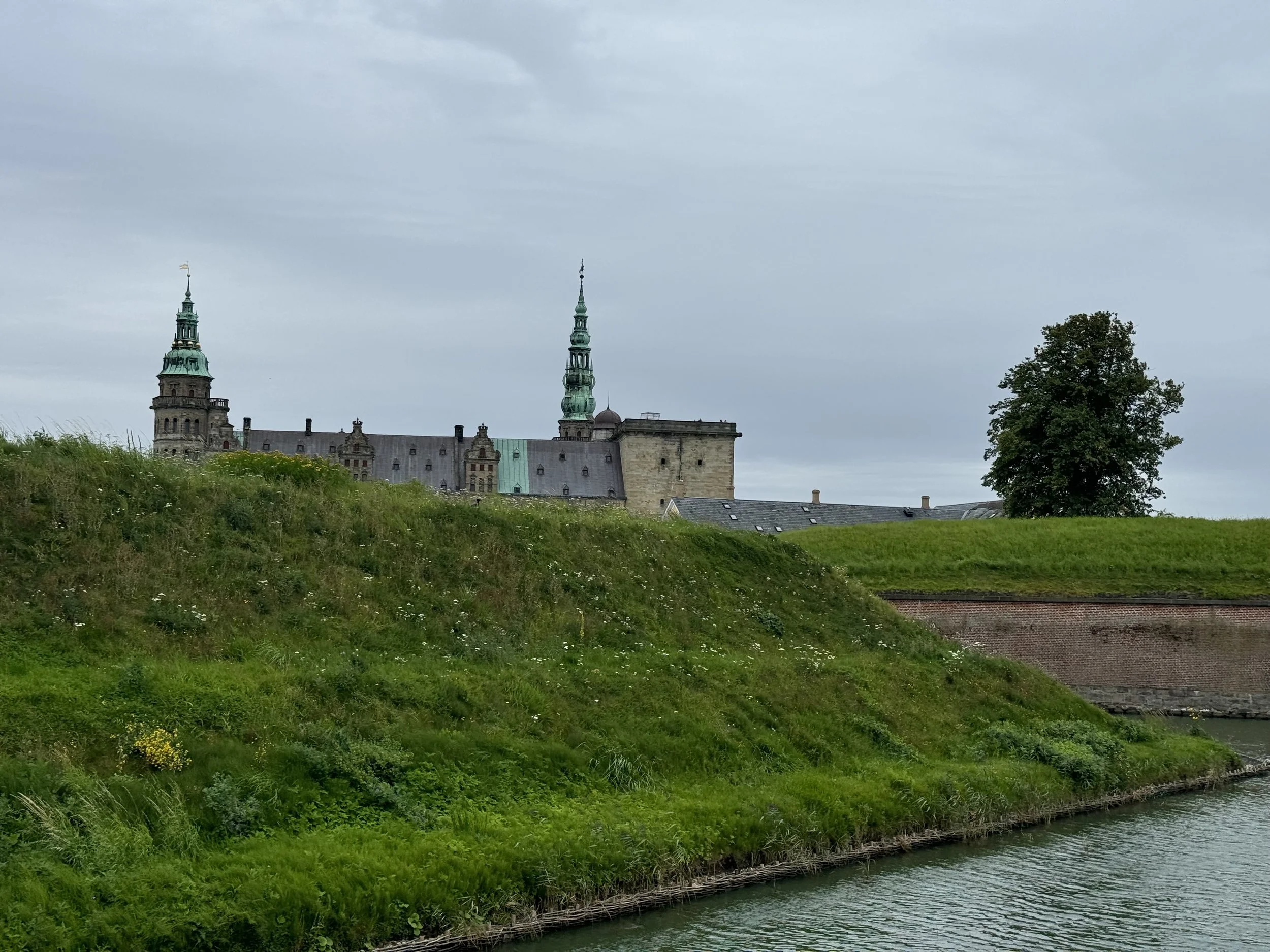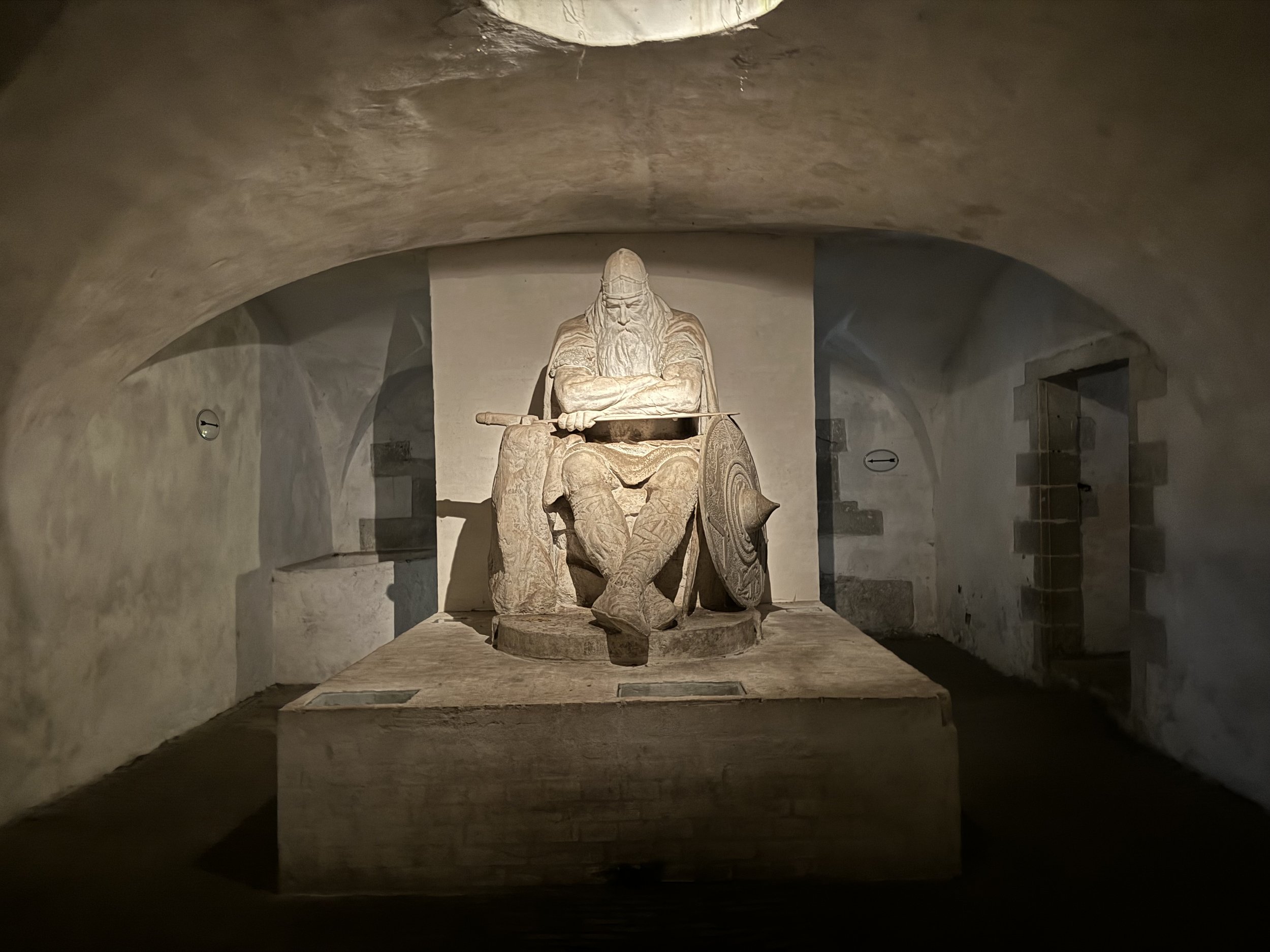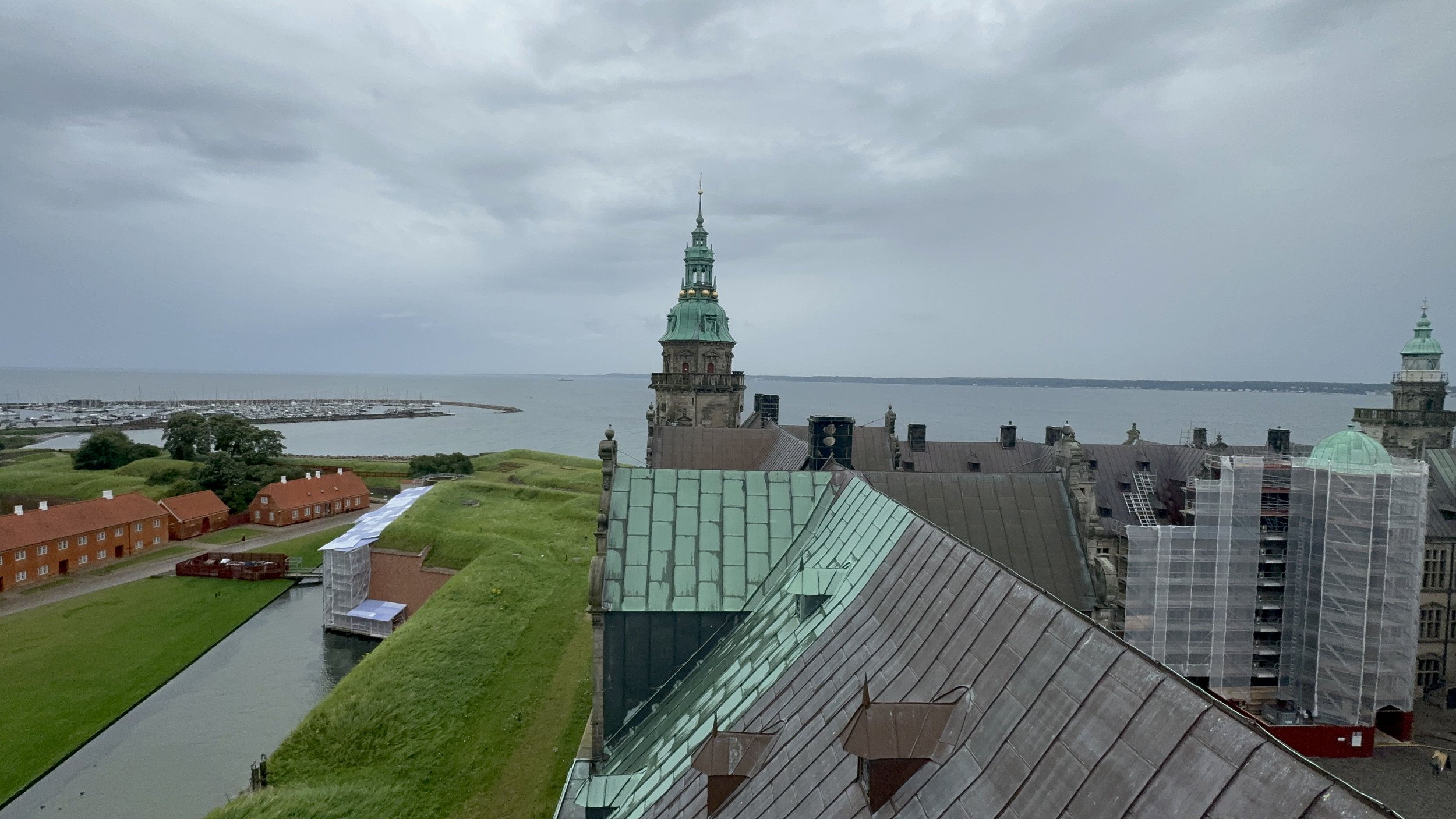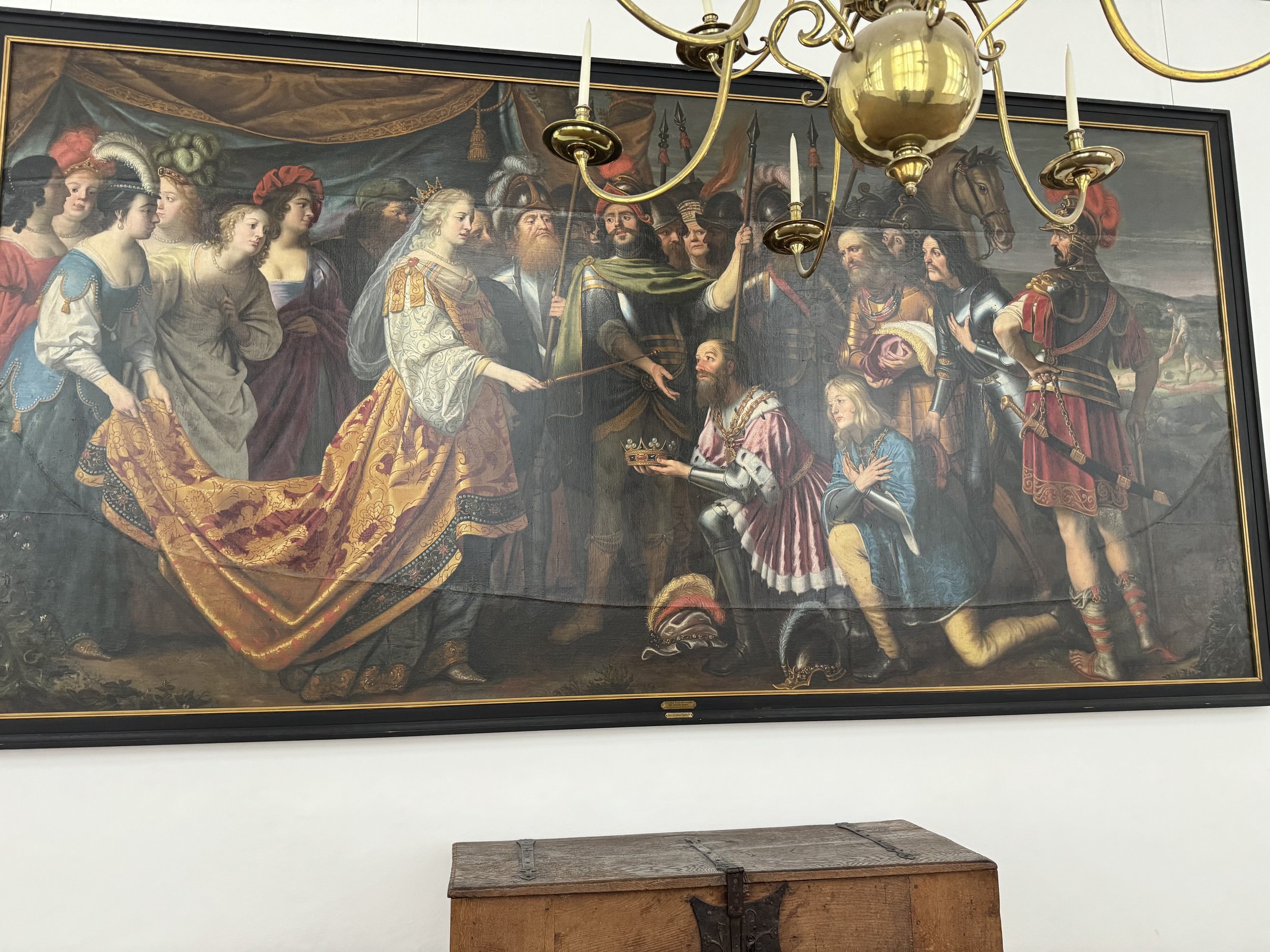The sleeping giant
Deep underneath Kronborgslot, Holger the Dane slumbers deeply, only to be awoken if Denmark comes under threat.
Today we made a day trip to Krongborg Castle in Helsingør, Denmark. It’s located on the northeastern side of the island of Zealand, directly across a body of water called the Øresund from Sweden. Immediately when leaving the train station at the port of Helsingør, you can see across the fairly short span of water into the city of Helsingborg, Sweden. Shipping, fishing, and ferry traffic dominate your view as you tear your eyes off the shimmering waterfront to behold the stark image of a giant wind and rain-swept castle and fortress on the coast. This is Kronborgslot, and it was William Shakespeare’s inspiration for the castle of Elsinore in the play Hamlet.
We fought our way over to the castle entrance through the intense wind and spitting rain. I can certainly see why Shakespeare took inspiration from the castle and its surroundings. We can certainly understand what he might have taken for Hamlet from the weather we were treated to. Cold, windy, and rainy were the orders of the day. Josh was in heaven. Jessi was a meat popsicle in an orange rain jacket. Poor Jessi had to keep taking her hearing aides out of her ears to mitigate agains the howling winds.
We toured the castle with fervor, climbing 145 spiral castle stairs to the canon perches on the roof for a beautiful view of the whole castle, battlements, and barracks. Jessi attempted to become a human kite in the blustery wind, but alas the strong winds failed to lift her. (Jessi here: it was a tiny bit disappointing to have so much wind and a giant wind breaker and not be able to convert myself into a kite! I’ll just have to try again when we come back!)
Kronborgslot was originally a smaller castle, known as the Krogen (the Hook). The castle is located strategically along the Øresund (strait) to control shipping traffic in the water between Sweden and Denmark. The museum had a small pile of “rose coins,” on display. Bringing goods from Sweden to to port of Helsingør required one such coin in tribute to the possessor of the castle (the Danish King). Frederik II erected a grand castle over the original Krogen in the mid-1500s, and the resulting royal residence became known as Kronborgslot. There is a story that Frederik II had originally intended to name the castle after his beloved wife Sophie (Sophieslot). As seems to happen to all things that are flammable in antiquity, the castle burned down less than a century later, and King Christian IV began the project to restore Kronborgslot to his own standards in the mid 1600s. In the 1700s, the castle was converted from a royal residence to a military barracks, where soldiers were stationed until 1923. The castle was renovated and returned to the public for visitation. There was a small divergence in the 1940s, when Denmark was occupied by Nazi Germany.
Easily the coolest thing in the castle were the casements and battlements, which you can wander. These underground passages take you deep beneath the castle and battlement walls! The Danes have chosen to keep the installation of modern lighting underneath the castle to a minimum, so these passages are lit with small oil lamps. The faint flicker of the oil lamps and their distinctive smell in the deep, dark, musty passages give you the feeling of going back in time, when invading Swedes forced the castle defenders to take haven in the casements for months. It must have gotten pretty rank down there! These passages originally housed horses and supplies for the castle, and served to protect the inhabitants in the event of an attack or siege.
Jessi here… the casements were easily one of the coolest things I’ve ever gotten to experience! I’ve spent a lifetime in the “public attractions” business, starting from the carnival my family owned and operated when I was a kiddo to public land management today. I could never have imagined this kid from Las Vegas, NV walking through the casements of a hundreds of years old castle in Denmark. There are almost no lights to guide your way, and the floor is not kept level. There are no plank floors or class casings to keep visitors safe. Instead, you are walking carefully through a dark, dank casement following the random directional arrow to find your way out. At times, I had to use my cell phone flashlight to see the floor before me. It was such a unique, one-of-a-kind experience that I will never forget! It was amazing to be able to touch the real walls and feel the real stone beneath my (sneaker-clad) feet.
In the dark gloom of these passages sits a giant. He is leaned forward and slumbering over his mighty sword. His name is Holger the Dane, and he passes the ages deep beneath Kronborgslot awaiting the call to action, when Denmark is threatened by outsiders. He will harken to the call and aid in the defense of Denmark and the defeat of the enemy. Until that time, he sits in the flickering oil lamp-light. His quiet snores fill the chambers, echoing in the darkness. On the wall in the chamber near to Holger is a list of similar stories from other cultures worldwide about similar protector stories. This was such a neat connection to the world!
From the casements, we proceeded to the royal chambers. Like much of the castle, the rooms have been renovated several times since the founding of the castle; however, we were treated to a recreation of the royal chamber of Frederick II and his wife Sophie. We learned that their chambers were carefully selected based on how easy it would be to heat them, and the selected rooms stayed warmer than much of the rest of the castle! To put the tour in perspective, this section was dotted with living history actors playing various roles from “Hamlet” who you could interact with. They seemed to speak many languages including Danish, English and German - so talented! We decided to leave them be and let the families with kiddos enjoy that part of the tour.
There is also a chapel that was miraculously untouched by the fire in the mid 17th century, but the pews and furniture were removed in order to use the space as a fitness hall for soldiers. After the soldiers moved out and the castle was returned to the public, all of the original furniture and the pews were returned to the chapel. It was reconstructed to look as it would have during the time of Frederik II. The organ of the chapel underwent restoration (the pipes), but the facade of the organ is original. Amazing! The chapel smells old. It smells like that ancient wood smell. It’s hard to describe, but you know it when you smell it.
The grounds of Kronborgslot are quite large, and we were pretty exhausted, so we ambled our way back to Helsingør train station, and we boarded a local train back to Hillerød. Tomorrow we plan to cross the Øresund by ferry to arrive in our next destination: Helsingborg, Sweden! We will see you there!











































